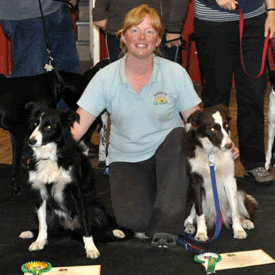Dog Training Tips (20/11/2020)
Joel Silverman – joelsilverman.net
Joel Silverman Dog Training

1. BUILD THE BOND FIRST
The biggest mistake dog owners make is training their dog before a relationship is established. The most important thing to remember is that most dogs want to please us. It is essential you get your dog in a place where he really wants to please you and make you happy. The way this is accomplished is by creating a trusting relationship using three steps before you train your dog:
a. Get to know your dog - Take about a week to find out the things your dog likes, and does not like.
b. Develop a relationship – Take about a week to incorporate the things your dog likes, and eliminate the things your dog does not like.
c. Build the trust – If you have spent the time to incorporate things your dog likes, you have now given your dog every opportunity to want to be around you, and you are now ready to train your dog.
2. TRAIN YOUR DOG BASED ON PERSONALITY
Another mistake dog owners make is falling into a trap, and training their dog based on something that sounds good. Train your dog based on his personality, and what he needs.
This is why I created the What Color is Your Dog?® dog training style. Your dog is one of five colors.. red, orange, yellow, green, or blue. Red and orange dogs are the warmer colored dogs. The Red dogs are extremely out of control, and the orange dogs are high strung, but not nearly as out of control as the red dogs. The yellow dogs are in the middle of the color spectrum, and are very laid back.
Then we have the cooler colored dogs which would be blue and green. The blue dogs are extremely afraid, and the green dogs are somewhat apprehensive, and not nearly as afraid as the blue dogs. The point is you would never train a cooler colored dog like a warmer colored dog. The warmer colored dogs need control, and the cooler colored dogs need motivation.
3. HAVE A GOAL EACH TRAINING SESSION
Another mistake owners make is not having a clear goal of what they plan to accomplish each training session. If you are teaching your dog to sit, you are not going to do that in one session. You are just going to be training a part of the behavior. Have a goal of what you want to accomplish and when you achieve that goal, end the session. Most importantly, end all training sessions on a positive note.
Nick White – Off Leash K9 Training
Nick White

1. The first key that is 100% essential is consistency! You have to see the same standard every time you work with your dog! Inconsistent training will give you an inconsistent dog.
2. Physical and mental exercise! A bored dog is a destructive dog. You have to get your dog thinking and active! Just like people, this is required to have a happy well rounded life.
3. I am big on confidence building! Like people, confident dogs and people are more successful! Look for ways to build your dog's confidence! Such as noise training, object training, socialization, and obedience.
Helen Taylor – Helen Taylor Dog Training & Behaviour
Helen Taylor
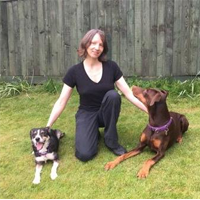
1. Always think about what behaviour your WANT your dog to do in any given situation, rather than what you want him to stop doing, or not do. Thinking about how to stop behaviour often leads owners to use punishment and negative techniques, which are far more likely to lead to behavioural problems (particularly aggression) and are often unsuccessful in the end - even if they appear to stop the behaviour at the time. Besides, while you are wondering how to stop a behaviour, your dog is busy rehearsing it - making it more likely to happen again.
2. If you don't want your dog or puppy to do a behaviour in the future, prevent it from happening in the first place so it does not become a habit (note that does NOT mean wait till he does it, then tell him off!). Therefore, do not allow your dog to practice socially inappropriate or undesirable behaviours (eg running up to every other dog he sees without invitation, begging at table, chewing furniture, peeing on carpets, jumping up). Instead, put steps in place to make it impossible for him to do these things, while you train him that other behaviours are more rewarding (and simultaneously prevent the formation of bad habits). Eg train a bomb proof recall BEFORE you let your dog off lead, Crate your pup at mealtimes while you train him that lying on his bed is more rewarding than begging, confine your puppy whenever he is not closely supervised for rapid house-training - and to prevent chewing, and train your dog that sitting to greet gets attention and reward
3. Work out what motivates your dog, and rank these by desirability (to him). Everything your dog wants and needs can come through you if you are strict (with yourself!) - and make sure to use the the most high-value reward for the most important or difficult behaviours.
Martin Deeley – Florida Dog Trainer
Martin Deeley
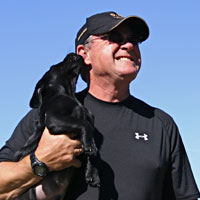
Routine - regular activity, housebreaking, crate time, with owner time guiding into acceptable behaviors and routines.
Guidelines - what the dog can and cannot do e.g. not on furniture, not in certain rooms etc.
Relationship - find out what pup enjoys and work at building a relationship on giving these rewards while building control simultaneously.
The moment that we take a dog into our family we have to realize that love and learning go together. Because we love our dogs we should help and enable them to learn behaviors and mannerisms that are enjoyed and acceptable both to others and ourselves. Good well behaved dogs create love for them and in doing so build a wonderful relationship for life. We must respect them, they are - dogs, with their own ways and inherent behaviors.
Training is often regarded as a hard word for what we do with our dogs. What we are really doing is teaching our dogs as we have been taught, what is and is not acceptable and what will enable them to enjoy their life. Training does not have to be hard, it should be fun and enjoyable and guide our dogs into being the ‘canine citizen’ and companion we will love and respect.
Training should be fun, dogs like humans learn from and want to do what is enjoyable. Training should guide our dog to the good behaviors we expect.
In life we all have limits and boundaries, dogs are no different. We owe it to our dogs to teach them through guidance, control and training, what is acceptable behavior. This is necessary for their own as well as your enjoyment of life together.
Have fun with your dog, make teaching a pleasure and both you and your dog will enjoy it. Spend time with your dog to create a relationship. Always have the ability to show what is required. A leash is your best friend and tool to help guide and show.
Although we all realize that we cannot be good at everything, training is not difficult and revolves around quality time not quantity time. There is always available the support of good professionals – dog trainers, veterinarians, groomers and kennel owners. Never be too proud to admit you are having a problem and deal with it the moment it happens, or even better avoid the problems by getting professional advice and help.
The IACP (www.canineprofessionals.com) is an Association of true Professionals who have the skills, and obtain great satisfaction from helping owners enjoy and love their dogs – their motivation is a lifetime of happy dog/owner relationships.
CeliaSue Hecht – celiasue.com
Celia-Sue-Hecht
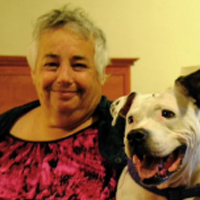
Here is what I would say based on what dog trainers that I respect teach (Victoria Stillwell, BADRAP and others). It is also based upon experience with my dog Cici who does NOT respond well to negativity in any form.
She cowers, shakes and runs away into a corner if someone yells at her. Threw up and peed when someone unpotty trained her when she was young. I potty trained her by giving her treats every time she did her business outside. Recently, I taught her how to use a doggie door (at age 9) by giving her treats.
She did not want to use the door and even seeing other dogs using it did not encourage her. Treats did the job and lots and lots of praise and eventually she did the doggie door on her own without me having to open the door for her.
1. Positive reinforcement works. Encourage your dog to do what you want by supplying positive feedback, whether that is rewards such as treats or praise.
2. Find out what works for your dog. In other words, some dogs, like my Cici, are VERY food motivated. But some dogs are more motivated by toys or other play. Cici could care less about toys (unless another dog has one then she wants it). Dogs are individuals just like people. One size does not fit all. Be patient, persistent and...
3. Bond with your dog by spending time together every day. Dogs who are family members (not left outside tied to a post 24/7 and not socialized) want to please their guardians/owners best friends. Dogs love to do what you want them to do, they seek to please you. Allow them to do their job and be dogs! Dogs hate to be left alone, they are part of a pack, yours! Honour their natural instincts and the rewards will be fabulous for you and your dog. Many behavioural problems are due to humans not understanding canines. Dogs are different from people -- read, research, learn and educate yourself!
Kelly Convey – Adventures of Kelly & Nelson
Kelly Convey
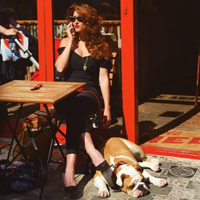
1. Whatever makes for an easy life now, will make for harder times later. I get it, your puppy is your baby, you want to wrap him/her up in cotton wool and do whatever makes them happy. Problem is, they grow and they get used to things like - sleeping in your bed, being fed from the table, sitting on the sofa - all of these things I let my puppy do and now he is a 9 stone Bulldog. I, personally, don't really mind these things but if you think you will later, don't start now.
2. Get them used to you not being around. There will always come a time when you need to leave your dog, even if it's just popping to the shop. From an early age, just practise walking out of the front door, waiting and coming back in. If they whine, try (and I know it's hard) to wait until they soothe themselves before you re-enter. This will avoid separation anxiety later.
3. Don't let your puppy just play with anything. When my Nelson was a pup, he got hold of a really old bra of mine - I thought, oh well, it's falling apart anyway - I'll just let him play with it. Now, if he so much as glimpses a bra, he wants to chew on it. This can be applied to ANYTHING you let them play with as a puppy - old shoes? I was throwing them out anyway... Flash forward two years and those brand new trainers are in pieces on the floor. Get them used to playing with their toys and their toys alone.
Lindsay Stordahl – That Mutt
Lindsay Stordahl

My top three tips for training a new dog include signing up for a group obedience class, beginning a serious daily walking routine with your dog and working on basic obedience commands every single day.
The obedience class is important because it provides opportunities to work with your dog around distractions. The instructor will also be able to provide suggestions for any issues that come up.
And I can't stress enough the importance of exercise. I recommend at least a 60-minute walk every single morning for the majority of dogs. Draining their energy helps them to stay relaxed and focused and easier to train.
Misaki and Dawn – The Misadventures of Misaki
Misaki and Dawn
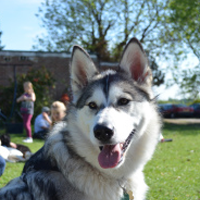
I would recommend starting early with routine health checks like claw clipping and teeth cleaning. The sooner you can get your dog used to having their paws handled and the feel of a tooth brush, or even just your finger brushing over their teeth, the better. Not only can this help prevent future health issues but also remove any resistance from your pet when their claws do need cutting etc.
Socialisation is so key to a dog's development, both with people and with other dogs. But also getting your dog used to different noises and situations is really important and can remove stress from new experiences. Walking through a busy town centre or even taking a ride on a bus can save a lot of anxiety in the future.
And lastly, start training early. Even before your puppy can go outside you can practice some basic commands at home. Repetition is definitely the answer. And when old enough enroll in a training class so you can combine socialisation and training :-)
Alfie Dog– Alfie's Diary
Alfie Dog
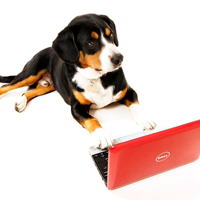
When it comes down to training your dog the results you get are entirely down to the time YOU put in.
We dogs are very little different to young children. Give us a book and tell us to go away and read it and our attention will wander.
Show us how to do something and watch us when we do it, praising us for success and we will want to do well and please you.
It doesn’t have to be a formal training session. Everyday interactions can just as easily be about training if you are clear about what you expect and praise us for the right behaviour.
Sonja Lishchynski – Montecristo Travels
Montecristo Travels

1) Carrier From the very beginning you want you dog to feel at ease in an airline approved travel carrier (for large dogs this means a large travel crate). For this I recommend you quickly select the carrier you wish to purchase and get your puppy - or even an older dog - to associate the carrier with a fun and safe place to be. We first left it on the ground with the door unzipped and open. A few days later as our little Montecristo got use to it, we tossed in 2-3 of his favourite treats. Before we knew it he was napping inside. Once that was happening we zipped up the door. Then right away open it. We did this for a few days and then we zipped it up and took him for a walk about the area with him inside. We then did a short drive. By the time we flew with him he loved being in his carrier and he was calm and relaxed.
2) Indoor potty training Obviously this applies to the toy breeds predominately. Airline travel is a lot easier if your little dog (under 20 pounds = dog plus airline approved carrier) is trained to use a pee pad. On very long flights, we take the dog, and carrier to the bathroom. Once the door is shut and LOCKED we then let him out, and put a pee pad on the ground. He can then release himself. This is not just useful for air travel but also for sailing and long train rides. Montecristo will use both the pee pad and go outside. He prefers outside but in a pinch, he will use the pee pad. Given our freezing Canadian winters, it is also good to have the indoor option when it is -35 Celsius outs there!
3) Noises An oft forgotten part of socialization is exposure to loud or bizarre noises. There are CD's you can buy that have a bunch of sounds you can play. Or you just go online to find them. We exposed our Montecristo to the noise of fireworks, planes, trains, honks, thunderstorms and much much more - this going on in the background while we played with him with his favourite toy. I believe this training helped a great deal with his remaining calm when we fly or when we introduce him to new activities like going on an airboat tour in the everglades.
Jacob (and Ruby, the dog) – My Untangled Life
My Untangled Life

1. Start right away. Many first time dog owners feel like they have all the time in the world for training but the moment your dog enters your home, they will start making their own rules if you don't start guiding them!
2. Consistency and repetition is key. Dogs, much like young children, thrive on knowing the rules to live by. They may push the limits at times, but establishing and repeating a pattern of behavior early on, as opposed to making it up as you go along, makes all the difference.
3. Reward good behavior. Everyone needs a good pat on the back sometimes to keep them motivated and validated. Dogs are no different and they love when they know they are being good!
Hazel Winstanley (with Zuki the dog) – Have Dog Can Travel
Have Dog Can Travel
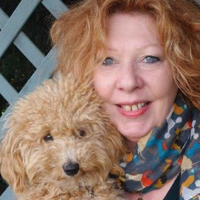
1.) The very best dog training tip I can give is to clicker train your dog to return to you when off lead.
It is the one thing that my little dog actually learnt from puppy training class and at the start involved a serious amount of Matteson’s sausage as a reward BUT I am so glad she learnt this.
It:
a. saves my voice when out
b. she doesn't get confused by other owners whistling.
Only yesterday she set off chasing rabbits and headed onto a golf course but one shout of her name followed by the standard 2 clicks of the clicker and she was back.
2.) Get the dog used to a travel carrier/bag early on – if they are used to this then journeys will be much more relaxed and also your car will be a lot cleaner! I couldn’t run the website I do if my dog wasn’t used to her travel bag – she feels safe and secure and I can drive for 3 hours without a peep out of her. Obviously if you have large dogs then you may have to consider a harness or crate in the boot BUT the main thing is to get them used to it early on.
3.) Make sure you spend time socialising your dog – they really do need to be introduced to other dogs and people as soon as possible. They need to get used to a range of people and children and dogs of all breeds and ages as well as traffic, towns, countryside and all that those environments entail. Your dog will then learn to adapt to new surroundings more quickly and be a confident and friendly companion.
K.Kelly – Kelford Dog Training Centre
Kelford Dog Training Centre

1. Realize your expectations before embarking on any training program.
2. Understand the mind pattern of the breed or combination breed that you own, and channel the dogs enthusiasm by working through a program that has been designed specifically for you and your canine, as this will enable your canine to happily fit into your lifestyle, rather than rule it. Thus owning a canine companion that reaches your expectations. You canine companion will then enhance your lifestyle.
3. Do not lure your dog into positive response by using treats, as you will simply become the canine's 'provider', and not the one the canine looks to willingly for direction. By introducing the correct techniques, the trust/respect bond will be created, that in turn will result in the development of a balanced canine/human relationship, and both owner & canine will then have the maximum opportunity to enjoy one another to the full.
Gail Ward – Cranbourne Dog Training School
Cranbourne Dog Training School
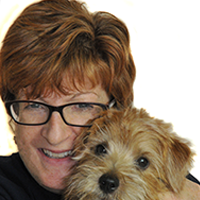
Tip one - socialise, socialise, socialise! Young pups need to see people, traffic, kids, bikes, horses etc etc and most important, lots (and I mean lots) of dogs on a DAILY basis. Too many clients come through our school only letting their dogs see other dogs at the weekend - pups must learn social graces with other dogs from an early age - specifically adult dogs - not other puppies!
Tip two - start early and establish ground rules for the pup so they know where they stand.
Tip three - Get everyone in the house to 'sing from the same hymn book' so pup isn't confused.
Karen Stanfield – Karen's Dogs
Karens Dogs

1. Research your chosen dog breed beforehand to ensure that the breed characteristics will fit into your life style.
2. When training your dog use treats, toys and praise as rewards and ignore and/or redirect any unwanted behaviour. Never use punishment.
3. Be consistent! Everyone in your family/household must have the same 'house rules' - for example are they allowed on the sofa? - to ensure your dog is never confused with what is expected of them.
Rosie Barclay – rosiebarclay.com
Rosie Barclay

Sit, come and wait are important behaviours to help keep your dog safe and teach self-control. However, it is important that your dog really wants to perform these rather than being made to.
So reward them with the things they like best when you first begin training and once they are performing these reliably you can reduce how often these rewards are given.
If you also tell them what a 'good dog' they are in a silly voice when they are eating or playing with the reward then your 'good dog' voice alone will also act as a reward. Make learning fun.
Pamela Webster – Something Wagging
Something Wagging

1) Practice training everywhere. A fifteen minute wait at the vet’s office is a great time to work on training with distractions.
2) Make it fun. Playing hide and seek is a blast and teaches your dog to pay attention to you.
3) Always carry a special treat or reward in your pocket for impromptu training moments.
Wendy Hill – Wendy Hill Dog Training
Wendy Hill Dog Training
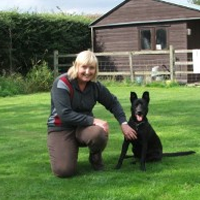
1) Do masses of research about the breed/type of dog you are considering and be very realistic about whether you have the time and commitment to take a canine companion into your life. Being a good dog parent is a 24/7 role.
2) Never buy online or from any advert/contact which could be a puppy farm or where you can’t visit the pups regularly and see the bitch with the pups and find out what early socialization and environment enrichment programme the breeder implements during the first 7-8 weeks of their lives. Expect to be grilled as to your suitability as an owner- good breeders care where their pups end up.
3) Research good quality puppy training in your area. You would want small groups, alliance to an ethical organization such as the APDT and a syllabus with emphasis on life and social skills not just obedience exercises.
Gemma Fisher Daybreak Dogs
1) Choose your puppy class carefully – do your research, ask other owners for their recommendations and if you can watch some training sessions before you commit. A good class will be happy to allow you to do this.
2) Try out different rewards for training your puppy. Don’t just stick with boring kibble or dried treats – check out my website for a range of ideas:
3) Focus on what you DO want as opposed to what you DON’T. Reward what you like and you’ll see more of it!


